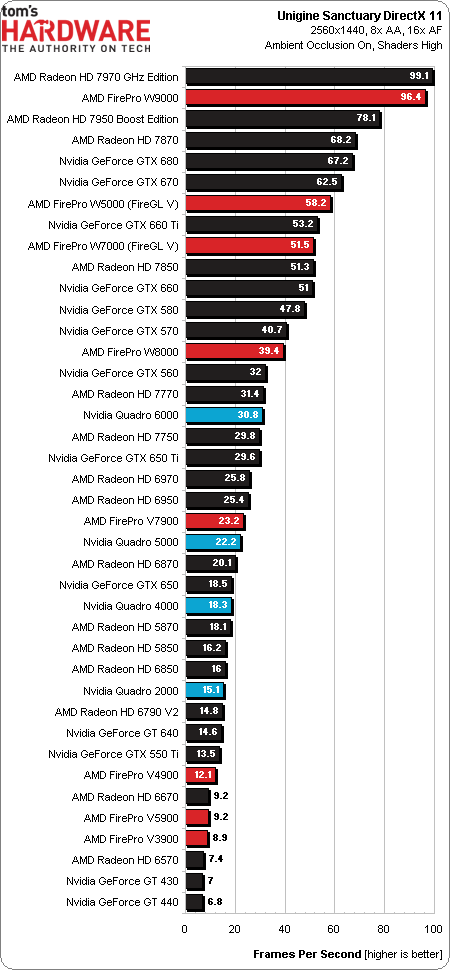How Well Do Workstation Graphics Cards Play Games?
We all know that gaming and workstation graphics cards employ the same hardware, differentiated by slight tweaks, drivers, and validation. We also know desktop cards usually perform awfully in professional apps. Does the reverse hold true as well?
Results: Unigine Sanctuary
Why you can trust Tom's Hardware
Unigine Sanctuary
Unigine Sanctuary is the last synthetic in our suite. The professional cards (from both AMD and Nvidia) get off to a slow start relative to the desktop boards, but manage a stronger showing once resolutions and settings get more demanding. At that point, we see the same unusual picture: AMD's FirePro W9000 solidly outperforms the other workstation cards. It’s on about the same level as the company's Radeon HD 7970 GHz Edition with its high clock frequency. The FirePro W8000’s performance is just sad.
Current page: Results: Unigine Sanctuary
Prev Page Results: Unigine Heaven Next Page DirectX 9 Results: Mafia IIGet Tom's Hardware's best news and in-depth reviews, straight to your inbox.

Igor Wallossek wrote a wide variety of hardware articles for Tom's Hardware, with a strong focus on technical analysis and in-depth reviews. His contributions have spanned a broad spectrum of PC components, including GPUs, CPUs, workstations, and PC builds. His insightful articles provide readers with detailed knowledge to make informed decisions in the ever-evolving tech landscape
-
MyUsername2 Are these cards so expensive because fewer people need to buy them, or do they really have that much more tech in them?Reply -
ipwn3r456 Umm, why not the newest Quadro K5000 is being benchmarked, but the newest FirePro W9000 is being tested here?Reply -
velocityg4 MyUsername2Are these cards so expensive because fewer people need to buy them, or do they really have that much more tech in them?Probably the former plus they can get away with charging more as business customers need them.Reply
Same with Enterprise hard drives. They are pretty much the same as regular hard drives. The only real difference is how they deal with data errors. The consumer drive will try to correct the error and recover the data causing the drive to not respond for a while and the RAID controller to thing it went bad potentially taking down the array when trying to rebuild. An Enterprise drive just notes the error and keeps chugging along asking the array for the corrupted data.
Now while the Enterprise hard drive is little more than a firmware change, making their price appalling. At least these workstation cards actually have some different chips and design requiring their own manufacturing equipment. So their higher price is more justified as they have to make changes to their line for a relatively small number of cards.
If they had a demand as high as the gaming cards their prices would probably be pretty close to their gaming counterpart. I'm sort of surprised one of them hasn't just unified their gaming and workstation line and dominate the workstation market. -
FormatC ReplyUmm, why not the newest Quadro K5000 is being benchmarked, but the newest FirePro W9000 is being tested here?
Ask Nvidia and take a look in the NDA- Try to buy one ;)
-
anxiousinfusion So its Toms suggesting that enthusiasts who want bleeding edge performance start building gaming machines with the W9000 cards?Reply -
moneymoneymoney @anxiousinfusion I would say that they're saying if you want professional performance in CAD & 3D Rendering software but also game on the same machine then these cards can do just that. Instead of buying two machines (one for work and one for gaming).Reply -
guvnaguy Do companies use these cards for any sort of video game design? If so I could see why they need optimized for both applications.Reply
Just goes to show how under-utilized the high-end gaming hardware is. If that kind of driver tweaking went into gaming cards, you could probably max out Metro 2033 on a 8800GTX, eh?
-
rmpumper I had a laptop with quadro fx3600m 3 years ago and from personal experience know that it was identical as the 8800GTm at gaming.Reply


